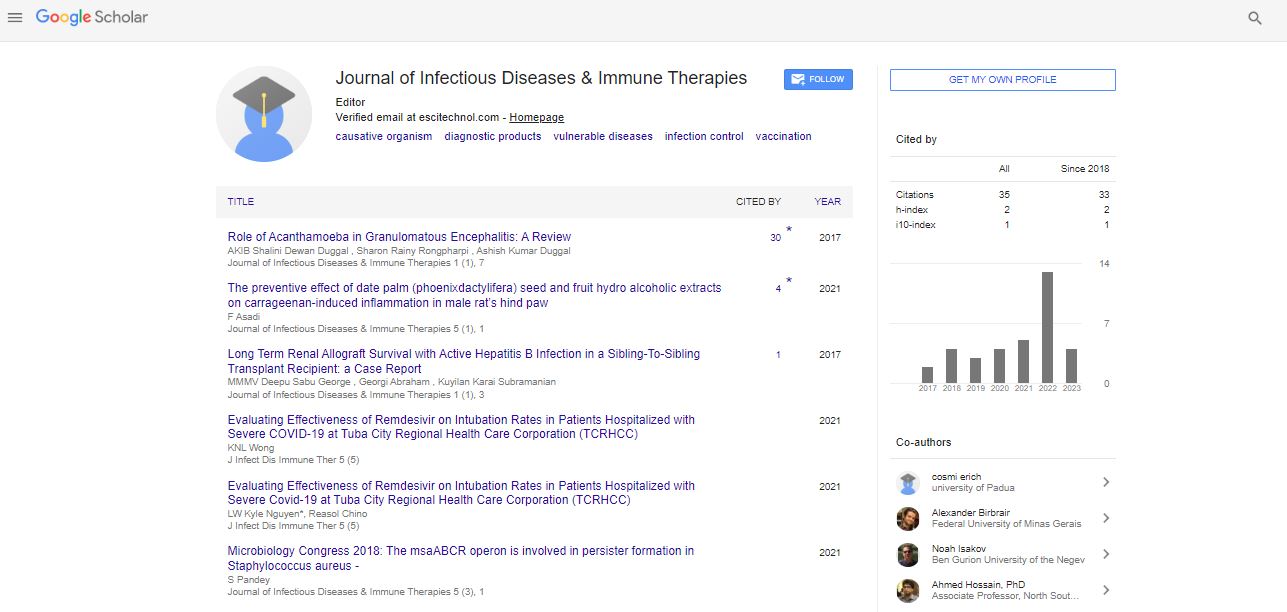Opinion Article, J Infect Dis Immune Ther Vol: 7 Issue: 1
Mycotic Infections in Immune-compromised Patients
Kohn Mansilha*
Department of Surgery, Keck School of Medicine of USC, University of Southern California, Los Angeles, California, United States of America
*Corresponding Author: Kohn Mansilha
Department of Surgery, Keck School of Medicine of USC, University of Southern California, Los Angeles, California, United States of America
E-mail: mansikohn@med.usc.edu
Received date: 03 February, 2023, Manuscript No. JIDITH-23-93630;
Editor assigned date: 07 February, 2023, PreQC No. JIDITH-23-93630 (PQ);
Reviewed date: 21 February, 2023, QC No. JIDITH-23-93630;
Revised date: 28 February, 2023, Manuscript No. JIDITH-23-93630 (R);
Published date: 07 March, 2023, DOI: 10.4172/JIDITH.1000152
Citation: Mansilha K (2023) Mycotic Infections in Immunocompromised Patients. J Infect Dis Immune Ther 7:1.
Description
Mycotic infections are caused by fungi and can affect various parts of the body, including the skin, lungs, and brain. Immunecompromised patients are at increased risk of developing mycotic infections due to their weakened immune systems. These infections can be life-threatening and difficult to treat, making early diagnosis and immediate treatment is important.
Causes
Immune-compromised patients are at increased risk of developing mycotic infections due to several reasons. One of the main causes is the use of immunosuppressive medications, such as corticosteroids, which weaken the immune system and increase the risk of infection. Other factors that can lead to immunosuppression include HIV/AIDS, cancer, organ transplantation, and autoimmune diseases.
Types
Immune-compromised patients are susceptible to a wide range of mycotic infections, including:
Candidiasis: This is a fungal infection caused by Candida species, which are commonly found in the human body. Candidiasis can affect various parts of the body, including the skin, mouth, throat, and genital area. In immune-compromised patients, candidiasis can become invasive and cause systemic infections.
Aspergillosis: This is a fungal infection caused by Aspergillus species, which are commonly found in the environment. Aspergillosis can affect the lungs, sinuses, and other organs in immunecompromised patients. It can also cause invasive infections that can be life-threatening.
Cryptococcosis: This is a fungal infection caused by Cryptococcus neoformans or Cryptococcus gattii, which were found in soil and bird droppings. Cryptococcosis can affect the lungs and cause meningitis in immune-compromised patients.
Histoplasmosis: Histoplasma capsulatum, which is found in soil contaminated with avian or bat droppings, causes this fungal infection.
Histoplasmosis can affect the lungs and cause disseminated infections in immune-compromised patients.
Pneumocystis Pneumonia (PCP): This is a fungal infection caused by Pneumocystis jirovecii, which is commonly found in the human respiratory tract. PCP can cause severe pneumonia in immunecompromised patients, particularly those with HIV/AIDS.
Mucormycosis: This is a fungal infection caused by Mucorales species, which are commonly found in soil and decaying organic matter. Mucormycosis can affect various parts of the body, including the lungs, skin, and brain, and can be life-threatening in immunecompromised patients.
Fusariosis: This is a fungal infection caused by Fusarium species, which are commonly found in soil and plant debris. Fusariosis can affect various parts of the body, including the skin, eyes, and lungs, and can be invasive and difficult to treat in immune-compromised patients.
Diagnosis and treatment
Diagnosis of mycotic infections in immune-compromised patients can be challenging due to the nonspecific symptoms and the difficulty in culturing fungi. Therefore, a combination of clinical features, radiological findings, and laboratory tests is often necessary for an accurate diagnosis. Treatment of mycotic infections in immunecompromised patients typically involves antifungal medications, such as amphotericin B, fluconazole, or voriconazole. However, treatment can be challenging due to the potential for drug interactions and toxicities.
Prevention
Prevention of mycotic infections in immune-compromised patients is essential and can be achieved through various measures. One of the most important measures is the use of prophylactic antifungal therapy in high-risk patients. Other measures include good hygiene practices, avoiding exposure to contaminated soil or water, and optimizing immunosuppressive therapy to minimize the risk of infection.
Challenges and opportunities
The management of mycotic infections in immune-compromised patients presents several challenges, including the difficulty in diagnosis, potential drug toxicities, and the emergence of antifungal resistance. However, there are also opportunities to improve the management of these infections through the development of new antifungal agents and the use of advanced diagnostic tools, such as next-generation sequencing.
Conclusion
Mycotic infections in immune-compromised patients are a significant healthcare challenge, with high morbidity and mortality rates. Early diagnosis and prompt treatment are important for improving patient outcomes. Prevention of these infections in high-risk patients is also essential. By implementing appropriate prevention and treatment strategies, healthcare providers can improve the management of mycotic infections in immune-compromised patients and reduce their impact on public health.
 Spanish
Spanish  Chinese
Chinese  Russian
Russian  German
German  French
French  Japanese
Japanese  Portuguese
Portuguese  Hindi
Hindi 